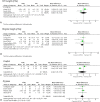High-flow nasal cannula versus non-invasive ventilation for acute hypercapnic respiratory failure in adults: a systematic review and meta-analysis of randomized trials
- PMID: 36352457
- PMCID: PMC9648030
- DOI: 10.1186/s13054-022-04218-3
High-flow nasal cannula versus non-invasive ventilation for acute hypercapnic respiratory failure in adults: a systematic review and meta-analysis of randomized trials
Abstract
Background: Non-invasive ventilation (NIV) with bi-level positive pressure ventilation is a first-line intervention for selected patients with acute hypercapnic respiratory failure. Compared to conventional oxygen therapy, NIV may reduce endotracheal intubation, death, and intensive care unit length of stay (LOS), but its use is often limited by patient tolerance and treatment failure. High-flow nasal cannula (HFNC) is a potential alternative treatment in this patient population and may be better tolerated.
Research question: For patients presenting with acute hypercapnic respiratory failure, is HFNC an effective alternative to NIV in reducing the need for intubation?
Methods: We searched EMBASE, MEDLINE, and the Cochrane library from database inception through to October 2021 for randomized clinical trials (RCT) of adults with acute hypercapnic respiratory failure assigned to receive HFNC or NIV. The Cochrane risk-of-bias tool for randomized trials was used to assess risk of bias. We calculated pooled relative risks (RR) for dichotomous outcomes and mean differences (MD) for continuous outcomes, with corresponding 95% confidence intervals (CI) using a random-effects model.
Results: We included eight RCTs (n = 528) in the final analysis. The use of HFNC compared to NIV did not reduce the risk of our primary outcome of mortality (RR 0.86, 95% CI 0.48-1.56, low certainty), or our secondary outcomes including endotracheal intubation (RR 0.80, 95% CI 0.46-1.39, low certainty), or hospital LOS (MD - 0.82 days, 95% CI - 1.83-0.20, high certainty). There was no difference in change in partial pressure of carbon dioxide between groups (MD - 1.87 mmHg, 95% CI - 5.34-1.60, moderate certainty).
Interpretation: The current body of evidence is limited in determining whether HFNC may be either superior, inferior, or equivalent to NIV for patients with acute hypercapnic respiratory failure given imprecision and study heterogeneity. Further studies are needed to better understand the effect of HFNC on this population.
Keywords: High-flow nasal cannula; Hypercapnic respiratory failure; Non-invasive ventilation.
© 2022. The Author(s).
Conflict of interest statement
The authors declare that they have no competing interests.
Figures




References
Publication types
MeSH terms
LinkOut - more resources
Full Text Sources
Medical

